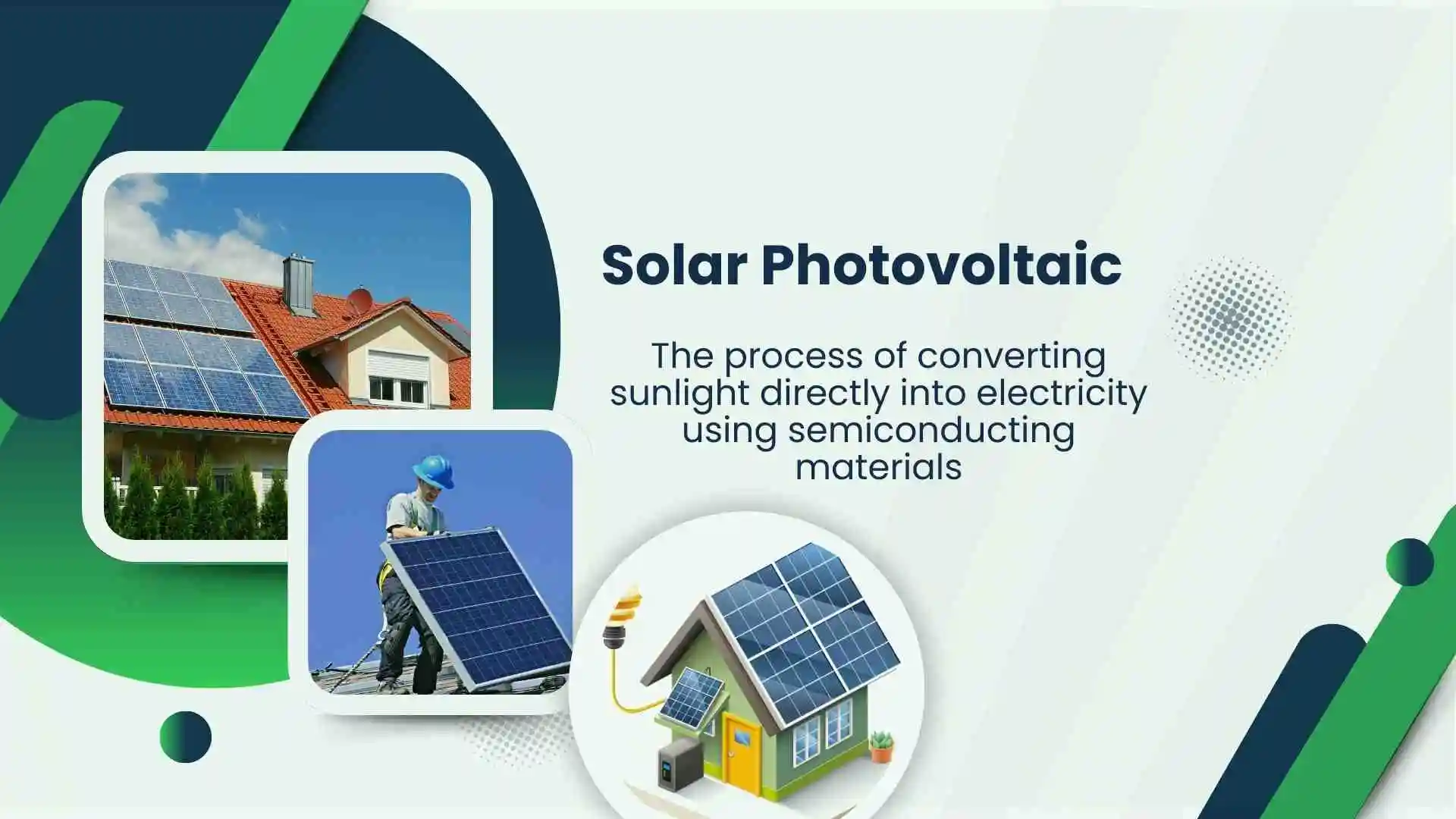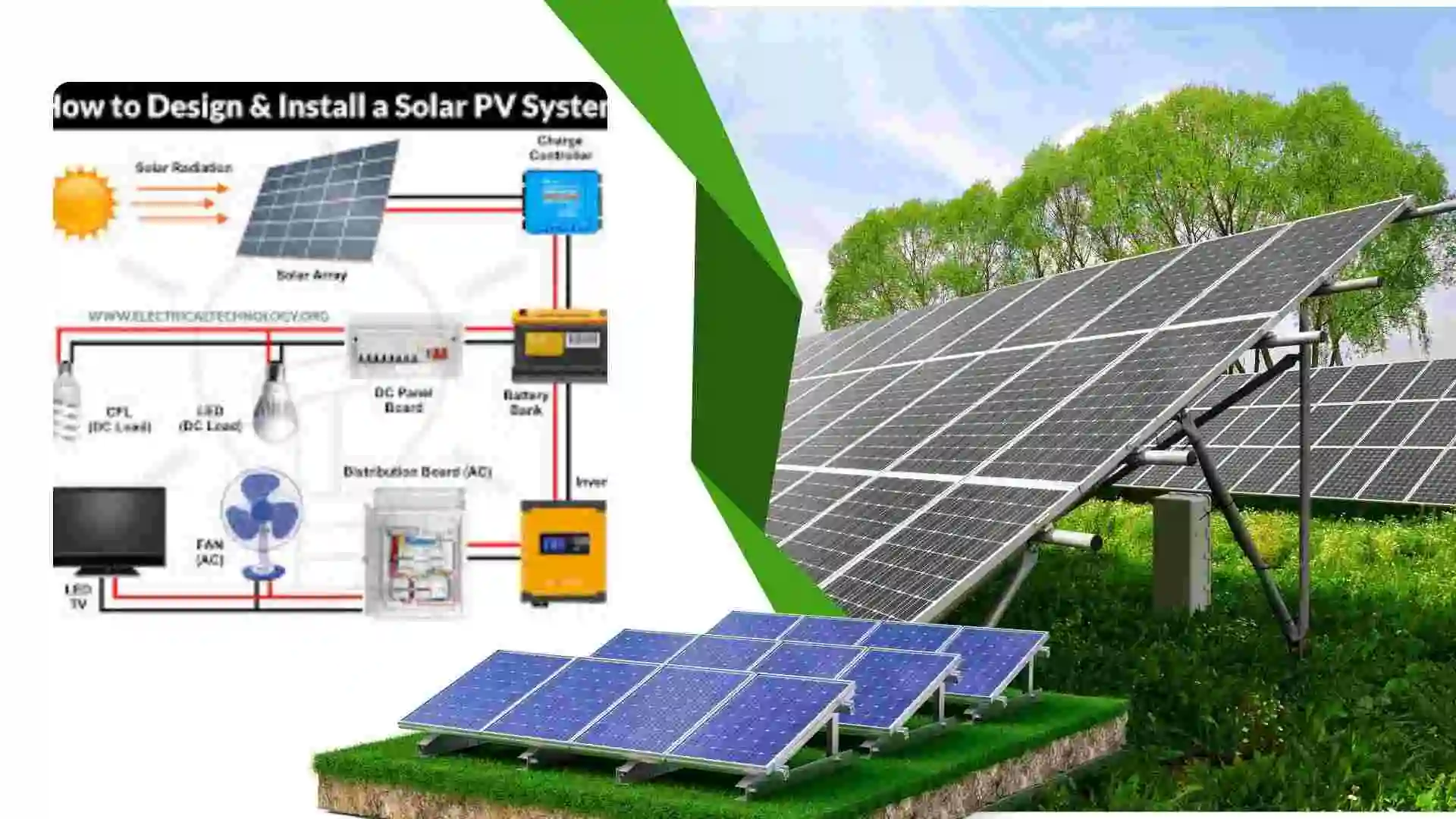Everything You Need to Know About Solar Photovoltaic Technology in 2025
As the world moves towards cleaner energy sources, Solar Photovoltaic (PV) technology is becoming increasingly popular. This guide covers everything you need to know about Solar PV in 2025, including how it works, its benefits, types, installation, and maintenance. Whether you’re thinking about adopting solar power or simply want to stay updated, this article will give you valuable insights.

If you want to know complete details about agricultural solar system then please visit Solar Energy in Agriculture.
What is Solar Photovoltaic (PV) Technology?
Solar Photovoltaic (PV) technology converts sunlight into electricity using solar cells made from semiconductor materials like silicon. When sunlight hits the panels, it causes electrons to move, generating electricity. This renewable energy source is becoming one of the most efficient ways to power homes and businesses.
Understanding Solar PV – The Basics Explained
Solar PV systems harness the power of sunlight to produce electricity. By using solar panels, they absorb light and convert it into electrical current. This technology is eco-friendly, reducing the need for fossil fuels while offering long-term savings on electricity bills.
How Does Solar Photovoltaic Work? A Simple Guide
Solar PV systems work by capturing sunlight through solar panels, converting it into direct current (DC) electricity. An inverter then changes the DC into alternating current (AC) electricity, which powers your home or business. Excess electricity can be stored in batteries or fed back into the grid.
Key Components of Solar Photovoltaic Systems
A solar PV system is composed of several components. Here’s a breakdown of the key parts:
| Component | Function |
|---|---|
| Solar Panels | Capture sunlight and convert it into electrical energy |
| Inverter | Converts DC electricity from the panels to AC electricity |
| Battery Storage | Stores excess electricity for later use (optional) |
| Mounting Structure | Supports the solar panels, either on the roof or ground |
| Charge Controller | Manages the flow of energy to the battery (if installed) |
Why Solar Photovoltaic is the Future of Clean Energy
Solar PV technology is key to reducing our reliance on fossil fuels and promoting sustainable energy sources. As global awareness of climate change increases, many countries are transitioning to clean energy, and solar Photovoltaic plays a major role in this shift.
Benefits of Solar Photovoltaic Technology
Solar PV offers several benefits:
Solar PV in the Global Energy Transition
Solar Photovoltaic is central to global efforts to reduce greenhouse gas emissions and shift to renewable energy. It helps countries meet their clean energy targets and reduce the environmental impact of electricity generation.
How Solar Photovoltaic Contributes to Reducing Carbon Footprints
Solar PV reduces carbon footprints by replacing fossil fuel-based energy generation. By using solar energy, you are directly reducing the amount of CO2 emissions released into the atmosphere, which contributes to global warming.
Types of Solar Photovoltaic Technologies
Different types of Solar PV technologies suit various needs. Understanding these technologies will help you make an informed decision based on your energy needs.

Monocrystalline vs. Polycrystalline Solar Panels – Which One to Choose?
When choosing between monocrystalline and polycrystalline panels, there are some key differences:
| Type | Efficiency | Cost | Best For |
|---|---|---|---|
| Monocrystalline | High | Expensive | Small to medium installations |
| Polycrystalline | Moderate | Affordable | Larger installations |
Thin-Film Solar PV – An Emerging Solution
Thin-film solar panels are lightweight and flexible, allowing for creative applications like solar roofs or curved surfaces. Though they are less efficient than crystalline panels, ongoing advancements are making them a viable option for specific needs.
Bifacial Solar Panels – Maximizing Solar Energy Capture
Bifacial panels capture sunlight from both the front and back sides, increasing efficiency. These panels are especially effective in areas with high reflectivity, like snow-covered regions or rooftops.
How to Install Solar PV Systems for Your Home or Business
Installing Solar PV systems involves several steps. Whether it’s for your home or business, proper installation ensures the system works efficiently.

Step-by-Step Guide to Solar PV Installation
Here’s a simple breakdown of the installation process:
Choosing the Right Solar Panels for Your Needs
Choosing the right solar panel depends on factors such as energy consumption, budget, and available space. High-efficiency panels like monocrystalline are ideal for limited space, while polycrystalline panels are more affordable for larger areas.
Understanding the Costs Involved in Solar PV Installation
The costs of Solar PV systems vary depending on the size, location, and type of panels. However, here’s a general overview of what to expect:
| Cost Factor | Estimated Cost |
|---|---|
| Solar Panels | $0.70 – $1.00 per watt |
| Inverter | $1,000 – $2,500 |
| Installation | $2,000 – $5,000 |
| Battery Storage | $5,000 – $10,000 (if included) |
Hiring a Professional – What to Look for in Solar Installers
When hiring an installer, make sure they are certified and experienced. Look for reviews, ask for references, and ensure they provide a warranty for the system. A good installer will help with everything from design to permits and post-installation support.
Solar PV System Maintenance and Troubleshooting
Regular maintenance of your Solar PV system ensures it operates efficiently and lasts longer. Here are some common tips and troubleshooting advice.
How to Maintain Your Solar PV System for Maximum Efficiency
Common Solar PV Issues and How to Fix Them
Common issues include:
Tips for Monitoring Solar PV System Performance
To ensure your system is working well, use a monitoring app or software. This lets you track energy production and alerts you to any issues, ensuring optimal performance.
Solar PV Energy Storage – What You Need to Know
Solar batteries store excess energy for later use. They help you become less reliant on the grid, especially at night or on cloudy days.
Understanding Solar Batteries and Energy Storage Systems
Energy storage systems, like lithium-ion batteries, store surplus solar energy. These systems allow you to use solar power even when the sun isn’t shining, providing greater flexibility and energy independence.
Benefits of Storing Solar Energy for Later Use
Storing solar energy helps you save on electricity costs and increase energy self-sufficiency. You can also use stored energy during peak hours when electricity rates are higher.

The Best Solar Batteries for Your PV System in 2025
Some of the top solar batteries in 2025 include:
These options offer high energy density, long lifespan, and excellent performance.
Solar PV Costs and Financial Considerations
While the initial cost of installing Solar PV systems may seem high, there are several ways to make it more affordable.
Solar PV Pricing Breakdown – What You Should Expect
On average, the cost of installing Solar PV for a residential system ranges from $10,000 to $30,000, depending on the system’s size. This includes equipment and installation costs but does not include possible incentives.
Financial Incentives, Tax Credits, and Rebates for Solar PV
Governments worldwide offer various financial incentives, including tax credits, rebates, and grants. In the U.S., the federal solar tax credit allows you to deduct up to 26% of the cost of your solar system from your taxes.
Financing Your Solar PV System – Loan vs. Lease
There are several financing options:
Solar PV and Grid Connection – How it Works
Connecting your Solar PV system to the grid allows you to send excess energy back and receive credits or payment.
Connecting Your Solar PV System to the Grid
Grid connection involves linking your system to the local utility, allowing you to use grid electricity when needed and send excess solar energy back.
Net Metering Explained – How You Can Earn from Your Solar Energy
Net metering allows you to earn credits for the electricity your system generates. These credits offset the cost of the power you use from the grid.
Off Grid Solar PV Systems – Is it the Right Choice for You?
Off-grid systems are ideal for remote locations or areas without grid access. They require larger battery storage to provide power during non-sunny periods.
The Future of Solar PV – Innovations and Trends
Solar PV technology continues to evolve, with new innovations that improve efficiency, cost-effectiveness, and flexibility.
Emerging Solar PV Technologies to Watch in 2025
Emerging technologies include:
These innovations promise to make solar power more accessible and efficient.
The Potential of Solar PV in Achieving Net-Zero Goals
Solar PV is crucial in reaching global net-zero emission goals. As technology improves and costs decrease, solar power is expected to play a leading role in sustainable energy worldwide.
Conclusion
Solar Photovoltaic (PV) technology has proven to be a powerful solution for a cleaner, more sustainable future. With its ability to harness sunlight and convert it into electricity, Solar PV offers numerous environmental and financial benefits, making it a key player in the global transition to renewable energy. From understanding the basics of how Solar PV works to exploring the different technologies and installation processes, there are many ways to integrate this clean energy source into your life.
As we move into 2025 and beyond, Solar PV continues to evolve with new innovations, such as bifacial panels and energy storage systems, that improve efficiency and reduce costs. With increasing government incentives, financing options, and advancements in technology, solar energy is becoming more accessible than ever. Whether you’re considering it for your home or business, investing in Solar PV is a smart decision for both environmental sustainability and long-term cost savings.
